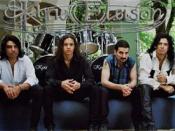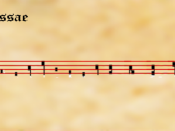Appreciation of Music Notes: Test 2
Kyrie from "Pange Lingua Mass" By: Duprez
Composer: Josquin (1510) Sacred music
Through Composed (music keeps changing)
Uses imitation; Choir only, genre: Kyrie
Form: 1 Kyrie Eleison (Lord have Mercy)
2 Christe Eleison (Christ have Mercy)
3 Kyrie Eleison (Lord have Mercy)
Kemps Jig; Genre: Jig
Composer: Anonymous around 1600 (end or Renaissance)
Instramentation: Recorder (early wind instrament),
viol (early string instrament), lute (early guitar)
Form: Binary (2 parts, A and B section) Repeat 5 times
Dance music usually homophonic
1st and 2nd Part: Recorder (Lute in background)
3rd Part: Viol (Lute in background)
4th and 5th Part: Duet between Recorder and Viol
Kemp was a Shakespearean actor who
sang and danced at intermission
Brandenburg Concerto No. 5, 1st Movement
Composer: Johanne Sabastian Bach (1685-1750)
Composed: 1721IMPORTANT: german composer
who got famous after death. Didn't invent new genre,
baroque ended with his death. Instramentation:
orchestra with concertino and ripieno
(Flute, Violin, harpsicord, standard orchestra)
Form: Ritornello (melody usually homophonic,
solo is polyphonic)Genre: Concerto Grosso
Dido's Lament from Dido and Aeneas
Composer: Henry Purcell (1689)
Binary form: II: A :II B I (sings remember me)
Genre: Opera (Aria and Recititive)
Soprano Voice, string instraments, group of 3 beats
Ostinato: repeating base line
Renaissance Period (1425-1600)
Means Rebirth.
Shift from sacred to secular
Age to discover. Sacred music had more freedom now
More polyphony, musical beauty now a concern
beyond just worship. Josquin Deprez and Giovanni Palestrina
most important sacred Renaissance composers.
Secular music: pop songs called Madrigals, more
Complicated Than troubadour songs, includes dance
with specific rhythem. Instramental Music begins to appear.
Word/Tone Painting: musically describing text
The Baroque Period (1600-1750)
(1 of the 3 important style periods)
Rise in secular music, now just as important
as sacred (rise in instramental) Rise of opera
(advanced secular vocal music) A muscial play/drama
where dialog Is sung, includes instrament.
Began 1600s during play's intermission, grew into separate
Work. Usually begins with an overture and alternates
between recitatives and arias. 7 note major/minor scales
:same as we use today. Functional harmony established:
building different chords on each note of scale,Chords built
in thirds, chord-tones v. non-chord tones, 1, 4, 5 chords are most important.
Key: all melodies and harmonies must come out of the same scale.
Terraced Dynamics: changing volume levels by adding
or subtracting players (Genre:Concerto Grosso)
Basso continuo: continuous bass, part played by combo
of low-pitched instrament (cello/bassoon)
And a chordial instrament (harpsicord/lute)
Ostinato: repetitive base line (also called a basso ostinato or
ground bass) pop music= riff Arcangelo corelli:
wrote some of first important pieces
Sonata: name for specific type of of instamentation music (never vocal)
Chamber music (rock band) v. orchestral music
Conductors introduced Baroque orchestra: mostly a large string
section with few winds, brss and percussion
Concerto: most important instramental genre of Baroque period. Two types
1: Solo concerto: soloist v. tutti (orcestra)
2: Concerto Grosso: concertino (small group of soloists) vs. Rest of orchestra.
Ritornello Form: most popular form used in convertos,
continuous alteration between Ritornello (main theme played by orchestra)
and new music by soloists. R1-S1-R2-S2-R3-S3
Fugue: genre using highest form of imitiative polyphony,
main theme called the subject, all instraments Play the subject during
the exposition, then alternations between episodes and re entries.
Dance Suite: collection of dance pieces, eventually not mean for dancing,
just listening. Could Be composed for orchestra.
Movement: large section of music, usually seperated by silence.
Usually 3 in concerto. 1- fast, 2- slower 3- fast


